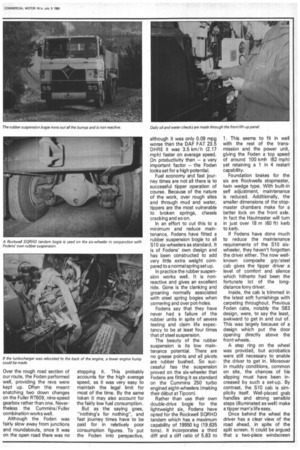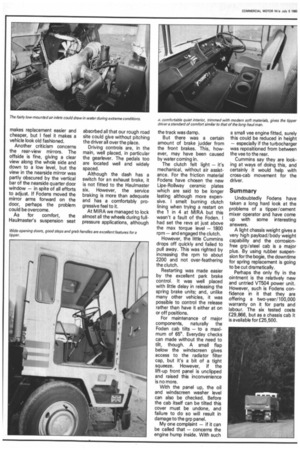New Foden is a goac tip for operators
Page 80

Page 81

Page 82

If you've noticed an error in this article please click here to report it so we can fix it.
Steve Gray road tests the latest Haulmaster 6x4 tipper,weighing in at just 6.18 tonnes.
Brian Weatherley took the pictures
TIPPER OPERATORS, probably more than any other group of vehicle users, regard maximum payload capability as one of the main requirements when choosing new chassis.
Hardly surprising, when before they even start to earn a crust a heavy robust body and weighty tipping gear must be added. Single, rather than twin tipping rams, and the extensive use of alloy, rather than steel, for the body, have increased the potential. But on sixwheelers in particular the addition of the lowest possible chassis-cab weight becomes essential.
To meet this demand, Fodens introduced a lightweight version of its Haulmaster 6 x 4 chassis before the Scottish Motor Show last year and it is this which forms the basis of our latest test.
The lightweight S10 Haulmaster features a turbocharged version of the Cummins small vee — the VT504 — and a Foden rubber rear suspension bogie. What is surprising is that it weighs in, in wet chassis cab form, at just 6.18 tonnes (6.08 tons).
Fodens achieved this remarkably low weight — which puts the Haulmaster among the lightest on the market — chiefly by using the Darlingtonbuilt Cummins VT504 in place of the Gardner 6LXC engine.
The naturally aspirated Cummins V504, from which the VT504 is derived, acquired a reputation for being thirsty, noisy and smokey as well as somewhat unreliable.
However, Cummins set about putting this right a couple of years ago by making certain improvements to the basic unit. More silent operation was achieved by fitting hard rubber sections in the rocker covers and sump.
There were also improvements to the lubrication system and many other components including injectors and the crankshaft. To match its faith in the unit, Cummins gave it a two-year warranty.
With the introduction of turbocharging to the engine, certain other changes were also made. The noise level was automatically reduced by 3dBA in conjunction with a drop of 200 rpm off maximum speed.
Other changes included a lowering of the compression ratio from 17 to 16 to 1 and more positive lubrication. However, the biggest change was the introduction of a "big cam" camshaft which at 63 mm (2.5 in) is 12 mm (1 in) larger than that on the naturally aspirated version. Faster injection results, and, coupled with turbocharging, the fuel is burned more rapidly.
Cummins say the results are greater flexibility and improved fuel consumption — 5 per cent better than the V504, and our test results more than bear out the claim. Compared with the Ford 2418, which was fitted with the V504, the Foden was 8.7 per cent more economical at 46.3 lit/100 km (6.1 mpg) overall round our tough tipper route.
And it was by no means slow. At an average overall speed of 41.1 km/h (25.57 mph) it was even quicker than the Ford which, up until then, had held the record as the fastest of all the vehicles we had taken round the route.
So Cummins engineers seem to have got it right, and the 300 kg (6 cwt) advantage the VT504 gives over rival engines makes it even more acceptable.
In the Foden application the VT504 gives out a maximum of 149 kW (199.5 bhp) at 2800 rpm compared with the 126.8 kW (170 bhp) at 3000 with the Ford V504 installation.
But like the Ford, the Cummins in the Foden was at its best when worked hard.
Over the rough road section of our route, the Foden performed well, providing the revs were kept up. Often this meant snatching two down changes on the Fuller RT609, nine-speed gearbox rather than one. Nevertheless the Cummins/Fuller combination works well.
Although the Foden was fairly slow away from junctions and roundabouts, once it was on the open road there was no stopping it. This probably accounts for the high average speed, as it was very easy to maintain the legal limit for most of the time. By the same token it may also account for the fairly low fuel consumption.
But as the saying goes, "nothing's for nothing", and fast journey times have to be paid for in relatively poor consumption figures. To put the Foden into perspective, although it was only 0.09 mpg worse than the OAF FAT 23.5 DHRE it was 3.5 km/h 12.17 mph) faster on average speed. On productivity then — a very important factor — the Foden looks set for a high potential.
Fuel economy and fast journey times are not all there is to successful tipper operation of course. Because of the nature of the work, over rough sites and through mud and water, tippers are the most vulnerable to broken springs, chassis cracking and so on.
In an effort to cut this to a minimum and reduce maintenance, Fodens have fitted a rubber suspension bogie to all S10 six-wheelers as standard. It is of Fodens' own design and has been constructed to add very little extra weight compared to a normalspring set up.
In practice the rubber suspension works well. It is nonreactive and gives an excellent ride. Gone is the clanking and groaning normally associated with steel spring bogies when cornering and over pot-holes.
Fodens say that they have never had a failure of the rubber units in spite of severe testing and claim life expectancy to be at least four times that of steel suspension.
The beauty of the rubber suspension is its low maintenance potential. There are no grease points and all pivots are rubber bushed. So successful has the suspension proved on the six-wheeler that Fodens are fitting it as standard on the Cummins 250 turbo engined eight-wheelers (making their cl&but at Tipcon).
Rather than use their own double-drive bogie for the lightweight six, Fodens have opted for the Rockwell SQR HD tandem which has a maximum capability of 19950 kg (19.635 tons). It incorporates a third diff and a diff ratio of 5.83 to 1. This seems to fit in well with the rest of the transmission and the power unit, giving the Foden a top speed of around 100 kmh (62 mph) yet retaining a 1 in 4 restart capability.
Foundation brakes for the six are Rockwells stopmaster, twin wedge type. With built-in self adjustment, maintenance is reduced. Additionally, the smaller dimensions of the stopmaster chambers make for a better lock on the front axle. In fact the Haulmaster will turn in just over 18 m (60 ft) kerb to kerb.
If Fodens have done much to reduce the maintenance requirements of the S10 sixwheeler, they haven't forgotten the driver either. The now wellknown composite grp/steel cab gives the tipper driver a level of comfort and silence which hitherto had been the fortunate lot of the longdistance lorry driver.
Inside, the cab is trimmed in the latest soft furnishings with carpeting throughout. Previous Foden cabs, notably the S83 design, were, to say the least, awkward to get in and out of. This was largely because of a design which put the door opening directly above the front wheels.
A step ring on the wheel was provided, but acrobatics were still necessary to enable the driver to get in. Moreover in muddy conditions, common on site, the chances of his slipping must have been increased by such a set-up. By contrast, the S10 cab is simplicity itself. Well-placed grab handles and strong sensible steps (illuminated as well) make a tipper man's life easy.
Once behind the wheel the driver has a clear view of the road ahead, in spite of the split screen. It could be argued that a two-piece windscreen makes replacement easier and cheaper, but I feel it makes a vehicle look old fashioned.
Another criticism concerns the rear-view mirrors. The offside is fine, giving a clear view along the whole side and down to a low level, but the view in the nearside mirror was partly obscured by the vertical bar of the nearside quarter door window — in spite of all efforts to adjust. If Fodens moved the mirror arms forward on the door, perhaps the problem could be overcome.
As for comfort, the Haulmaster's suspension seat absorbed all that our rough road site could give without pitching the driver all over the place.
Driving controls are, in the main, well placed, in particular the gearlever. The pedals too are located well and widely spaced.
Although the dash has a switch for an exhaust brake, it is not fitted to the Haulmaster six. However, the service braking is more than adequate and has a comfortably progressive feel to it.
At MIRA we managed to lock almost all the wheels during fullpressure applications, although the track was damp.
But there was a certain amount of brake judder from the front brakes. This, however, may have been caused by water coming in.
The clutch felt light it's mechanical, without air assistance. For the friction material Fodens have chosen the new Lipe-Rollway ceramic plates which are said to be longer lasting although more expensive. I smelt burning clutch lining when trying a restart on the 1 in 4 at MIRA but this wasn't a fault of the Foden. I had set the revs at just above the max torque level — 1800 rpm — and engaged the clutch.
However, the little Cummins drops off quickly and failed to pull away. This was righted by increasing the rpm to about 2200 and not over-feathering the clutch.
Restarting was made easier by the excellent park brake control. It was well placed with little delay in releasing the spring brake units; and, unlike many other vehicles, it was possible to control the release rather than have it either at on or off positions.
For maintenance of major components, naturally the Foden cab tilts — to a maximum of 65°. Everyday checks can made without the need to tilt, though. A small flap below the windscreen gives access to the radiator filter cap, but it's a bit of a tight squeeze. However, if the lift-up front panel is unclipped and raised this inconvenience is no more.
With the panel up, the oil and windscreen washer level can also be checked. Before the cab itself can be tilted this cover must be undone, and failure to do so will result in damage to the grp panel.
My one complaint — if it can be called that — concerns the engine hump inside. With such a small \tee engine fitted, surely this could be reduced in height — especially if the turbocharger was repositioned from between the \tee to the rear.
Cummins say they are looking at ways of doing this, and certainly it would help with cross-cab movement for the driver.
Summary
Undoubtedly Fodens have taken a long hard look at the problems of a tipper/cement mixer operator and have come up with some interesting answers.
A light chassis weight gives a very high payload/body weight capability and the corrosionfree grp/steel cab is a major plus. By using rubber suspension for the bogie, the downtime for spring replacement is going to be cut dramatically.
Perhaps the only fly in the ointment is the relatively new and untried VT504 power unit. However, such is Fodens confidence in it that they are offering a two-year/100,000 warranty on it for parts and labour. The six tested costs £29,866, but as a chassis cab it is available for £25,500.
In brief
Price as tested: £29,866 Price of chassis cab: £25,500 Weig ht:
24.32 tonnes (23.94 tons)
Overall fuel consumption: 46.3 (it,' 100 km (6.1 mpg)
Overall average speed:
41.1 km/ h (25.57 mph)
Power to weight ratio:
6.1 kW /tonne 18.3 bhp/ton)












































































































































































































